Did you know that cats are not actually nocturnal? Contrary to popular belief, these furry creatures have a unique sleep pattern that sets them apart from truly nocturnal animals. While some cats may exhibit more nocturnal behavior, they are considered crepuscular, meaning they are most active during the twilight hours of dawn and dusk. Understanding the sleep habits of cats can help pet owners better manage their nighttime activities and ensure a harmonious sleep routine for both feline and human.
Key Takeaways:
- Cats are crepuscular animals, meaning they are most active at dawn and dusk.
- Their sleep patterns are influenced by their natural hunting instincts and genetic makeup.
- Cat owners can manage their cats’ nighttime activities by establishing a consistent schedule and providing enrichment toys.
- Cats’ sleep behavior is similar to that of their larger, wild counterparts.
- If you have concerns about your cat’s sleep habits, consult with a veterinarian for guidance and support.
Cats’ Sleeping Patterns and Behavior
Cats have unique sleeping patterns compared to humans. While they do sleep for significant periods during the night, they also have short bursts of intense activity. This is because cats are always on alert even when they are sleeping, which is a result of their natural instincts as hunters.
Cat’s sleep is different from true nocturnal animals, as they do not sleep for long sessions during the day. Their playful behavior at night is a way for them to burn energy and satisfy their hunting instincts. Cats’ sleep schedule is influenced by their natural behavior and can vary from cat to cat. Some cats may be more active at night, while others may prefer to sleep through the night and be more active during the day.
Understanding your cat’s sleeping patterns and behavior can help you create a suitable environment and schedule that meets their needs. It is important to provide them with a comfortable sleeping area, such as a cozy bed or a designated sleeping spot, where they can rest undisturbed.
The Difference Between Nocturnal and Crepuscular Animals
Nocturnal animals sleep throughout the day and are primarily active during the night, while diurnal animals are active during the day and sleep at night. Crepuscular animals, like cats, are most active at dawn and dusk, taking advantage of the cooler temperatures and the reduced risk of predators. This behavior allows them to balance their need for activity with the need to stay safe. Cats’ crepuscular behavior is governed by their genetics and evolutionary adaptations as hunters.
Why Cats Are Active at Night
Cats’ activity at night is driven by their natural hunting instincts. Many of their prey species, such as rodents, tend to be more active at night. This is why cats are more inclined to play and hunt during the nighttime hours. Cats have retained their hunting skills and are less dependent on humans for their source of food, which is why they engage in behaviors like chasing toys and pouncing on objects. This behavior is a reflection of their evolutionary adaptations as hunters and their innate need for mental and physical stimulation.
The Role of Hunting Instincts
Cats are natural hunters, with a strong prey drive that compels them to stalk and capture small animals. This instinct is deeply ingrained in their evolutionary history, even domesticated cats display hunting behaviors. Hunting serves multiple purposes for cats, beyond just obtaining food. It allows them to exercise their hunting instincts, provides mental stimulation, and helps maintain their physical fitness.
To satisfy their hunting instincts, cats need opportunities for interactive play. Engaging in play sessions with toys that mimic the movements of prey can channel their instincts and provide an outlet for their hunting behavior. These play activities help keep them mentally and physically stimulated, reducing boredom and potential behavioral issues.
Prey Species and Nighttime Activity
Many of the prey species that cats evolved to hunt, such as mice, rats, and other small rodents, are primarily active during the night. These animals have developed adaptations that allow them to avoid predators during their most active period. Cats, being excellent hunters, have honed their hunting skills to take advantage of their prey’s nocturnal behavior.
By being active at night, cats increase their chances of encountering and capturing their prey. Their acute senses, such as sharp night vision and sensitive hearing, make them efficient nighttime hunters. Although domesticated cats don’t rely on hunting for sustenance, their instincts are still strong and can drive their activity at night.
Nocturnal vs. Crepuscular Behavior
While cats are often mistaken for being nocturnal, they are actually considered crepuscular animals. Nocturnal animals are primarily active during the darkness of night, whereas crepuscular animals, like cats, are most active during the transitional periods of dawn and dusk. This behavior allows them to take advantage of the available light and the increased activity of their prey. Being crepuscular is an advantageous adaptation that helps cats balance their need for activity with the need to avoid predators that are active during peak daylight and darkness hours.
| Cat Hunting Instincts | Cat Prey Species | Cat Activity during the Night |
|---|---|---|
| Strong and ingrained | Mice, rats, small rodents | Increased chances of encountering and capturing prey |
| Drive hunting behavior | Nocturnal animals | A reflection of their evolutionary adaptations as hunters |
| Require interactive play | Prey species with nighttime activity | Opportunities for mental and physical stimulation |
Understanding and accommodating cats’ natural hunting instincts is essential for their well-being. Providing them with interactive toys, engaging play sessions, and opportunities to satisfy their predatory needs can help prevent boredom, reduce undesirable behaviors, and promote a balanced and healthy lifestyle.
Evolutionary Comparison to Big Cats
Domestic cats share sleep habits with their larger, wild counterparts. Just like their wild relatives, most big cat species are known for hunting during the night when their prey is active. While not all big cats have the same sleep patterns as domestic cats, some, like tigers, exhibit nocturnal behavior.
Domestic cats’ sleep habits reflect their evolutionary continuity with their wild relatives. This similarity in sleep patterns and hunting behaviors across different cat species demonstrates the innate instincts and genetic connections that drive their behavior.
To further explore this evolutionary link, let’s take a closer look at some comparative examples of big cat sleep patterns and wild cat behaviors:
Lion Sleep Patterns
Lions, one of the largest big cat species, are known for their social structure and hunting behavior. They typically spend most of the day resting, conserving energy for their active night hours. Lions often sleep for 15 to 20 hours a day, primarily during the daylight hours.
Tiger Sleep Patterns
Tigers, the largest cat species, have a wide range of sleeping patterns depending on their habitat and hunting conditions. While they are not strictly nocturnal, tigers often exhibit crepuscular behavior, being most active during dawn and dusk. This behavior allows them to take advantage of the low-light conditions when their prey species are active.
Leopard Sleep Patterns
Leopards, known for their elusive nature and exceptional climbing abilities, demonstrate a more flexible sleep pattern. They are highly adaptable to their surroundings and can adjust their sleep habits accordingly. Leopards often show a combination of nocturnal and crepuscular behavior, making them effective hunters both during the night and at dawn or dusk.
Cheetah Sleep Patterns
Cheetahs, renowned for their incredible speed, have unique sleep patterns that distinguish them from other big cat species. Cheetahs are more diurnal, meaning they are active during the day and sleep mainly at night. They rely on their great speed and agility to chase down prey species that are active during the day.
| Big Cat Species | Sleep Patterns | Activity Time |
|---|---|---|
| Lion | 15 to 20 hours/day | Nocturnal and crepuscular |
| Tiger | 13 to 18 hours/day | Crepuscular and nocturnal |
| Leopard | 10 to 13 hours/day | Crepuscular and nocturnal |
| Cheetah | 12 to 16 hours/day | Diurnal |
As the table illustrates, big cat sleep patterns vary among different species. However, they all exhibit sleep behaviors that align with their hunting instincts and the activity patterns of their prey.
Understanding the sleep habits of big cats helps us gain insights into the natural behaviors of our domestic feline companions. While they may have adapted to different environments, their common evolutionary heritage can inform our understanding of cat sleep habits and behaviors.
Understanding Cat Naps
Cats have unique sleep patterns that differentiate them from humans. While humans typically have long periods of uninterrupted sleep, cats take frequent power naps throughout the day, interspersed with short bursts of activity. This type of sleep cycle allows cats to remain constantly alert and ready to respond to any potential threats or hunting opportunities that may arise.
Unlike humans who require several hours of continuous sleep, cats thrive on short bursts of rest, which is deeply rooted in their natural instincts. By taking multiple cat naps, they conserve their energy for when it’s most necessary, such as during hunting or playtime.
During a cat nap, a feline will doze off for about 15 to 30 minutes, and then quickly wake up, ready to spring into action if needed. They are always on high alert, even when seemingly asleep, due to their acute senses and predator instincts.
To better understand cat napping behavior, it’s helpful to explore their sleep cycles. Cats experience both non-REM sleep, which is a light sleep stage, and REM (rapid eye movement) sleep, which is associated with dreaming and deep restfulness. During REM sleep, cats may exhibit twitching or movements of their legs and tail, indicating an intense level of rest and mental stimulation.
Cat napping behavior is crucial for their overall well-being and survival. Through these short resting periods, cats can maintain constant vigilance, conserve their energy, and be ready to respond to stimuli in their environment. Understanding and respecting their unique sleep patterns is essential for providing a conducive and enriched living space for our feline companions.
Managing Your Cat’s Nighttime Activity
While you may not be able to completely change your cat’s natural instincts and behavior, there are steps you can take to manage their nighttime activity. Establishing a consistent schedule, providing regular exercise during the day, and offering enrichment toys can help redirect their energy and promote better sleep at night. Additionally, creating a comfortable and cozy sleeping environment for your cat can encourage them to rest during the nighttime hours.
Tips for Managing Cat Night Behavior
- Establish a consistent sleep schedule for your cat, aligning it with their natural crepuscular instincts.
- Provide regular exercise sessions during the day to help burn off excess energy.
- Engage your cat in interactive playtime in the evening to simulate hunting behavior and tire them out before bed.
- Offer enrichment toys, such as puzzle feeders or interactive toys, to keep your cat mentally stimulated and engaged during the night.
- Create a quiet and comfortable sleeping space for your cat, away from noise and distractions.
- Consider using calming aids, such as pheromone diffusers or soothing music, to create a relaxing environment that promotes sleep.
- Avoid feeding your cat a large meal right before bedtime, as it may lead to digestive discomfort and more nighttime activity.
By implementing these strategies, you can help manage your cat’s nighttime activity and promote a healthier sleep schedule for both you and your feline companion.
Talking to Your Veterinarian about Sleep Issues
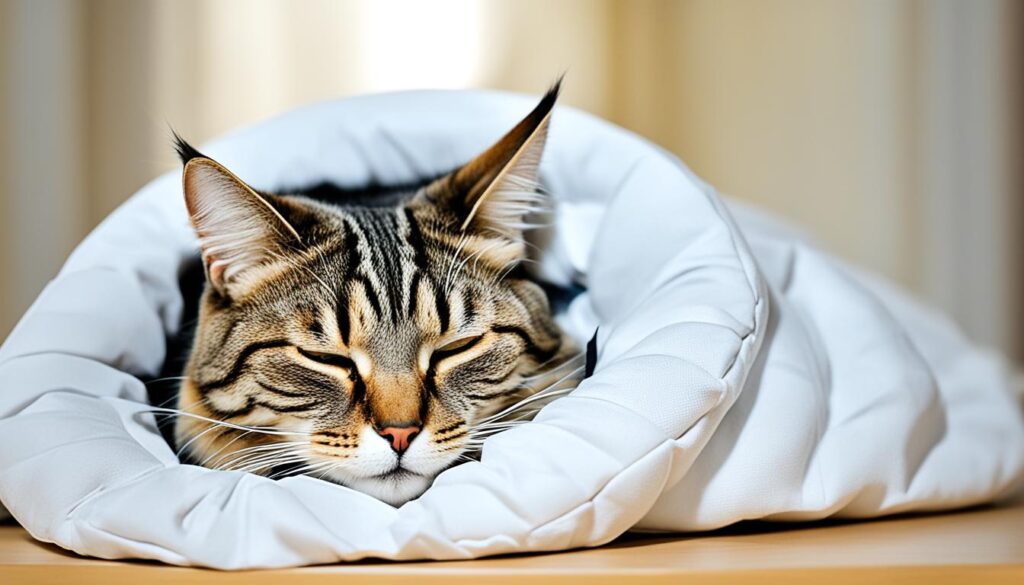
If you’re concerned about your cat’s sleep schedule or any unusual nocturnal behaviors, it’s best to consult with your veterinarian. They can assess your cat’s overall health and rule out any underlying medical conditions that may be affecting their sleep patterns. Cats can experience insomnia or excessive sleep if they are in pain or suffering from certain health issues. Your veterinarian can provide guidance and recommend appropriate measures to address any sleep-related concerns.
It’s important to remember that sleep problems in cats can be indicative of underlying health conditions. Consulting with a veterinarian can help identify the root cause and provide effective solutions to improve your cat’s sleep quality and overall well-being.
Common Cat Sleep Problems
Cats can experience various sleep problems that may require veterinary intervention. Some common cat sleep problems include:
- Insomnia: If your cat has trouble falling asleep or staying asleep, it could be a sign of underlying health issues, stress, or anxiety.
- Excessive Sleep: While cats are known for sleeping for long hours, excessive sleep or lethargy can be a symptom of illness or an underlying medical condition.
- Restless Sleep: If your cat frequently wakes up during the night, tosses, turns, or exhibits signs of discomfort, it’s essential to get them evaluated by a veterinarian.
These sleep problems can be caused by a range of factors such as pain, dental issues, hormonal imbalances, obesity, or even certain medications. Cats with sleep problems may exhibit changes in behavior, appetite, and overall energy levels. Timely veterinary consultation can help identify and address these issues.
Consulting with Your Veterinarian
When discussing your cat’s sleep issues with your veterinarian, it’s essential to provide relevant information about their sleep patterns and behaviors. Here’s what you can expect during a veterinary consultation:
- Medical History: Your veterinarian will ask about your cat’s medical history, including any pre-existing conditions, current medications, and recent lifestyle changes.
- Observations and Symptoms: Describe any unusual sleep behaviors, such as excessive sleep, restlessness, or insomnia, along with other symptoms your cat might be experiencing.
- Physical Examination: Your veterinarian will conduct a thorough physical examination, including checking your cat’s body weight, muscle tone, and overall condition.
- Diagnostic Tests: In some cases, your veterinarian may recommend further diagnostic tests, such as blood work, urine analysis, or imaging, to identify any underlying medical conditions.
- Treatment Plan: Based on the findings, your veterinarian will develop a customized treatment plan to address your cat’s sleep issues. This may involve medication, dietary changes, environmental modifications, or behavior management techniques.
Remember, early intervention and proper veterinary care are crucial when it comes to managing your cat’s sleep problems and maintaining their overall health and well-being.
Cat Sleep and Dreams
Cats have fascinating sleep patterns and behavior that differ from humans. They experience both non-REM and REM sleep, just like us, but their sleep is tailored to their unique instincts and needs. During sleep, cats are always alert, even while dozing, and can quickly wake up if they sense any unusual noises or movements.
One interesting aspect of cat sleep is dreaming. Dreaming is a common behavior during REM (Rapid Eye Movement) sleep, which is the stage of sleep associated with vivid dreams in humans. Cats may exhibit dream-like movements such as twitching or moving their legs or tail while sleeping, indicating that they are in a deep and restful sleep state.
It’s important to respect your cat’s sleep and not disturb them while they are dreaming. Waking up a dreaming cat abruptly can startle or frighten them, affecting their overall sleep quality. Allow your feline friend to fully enjoy their dreams and rest undisturbed.
Now, let’s take a closer look at the different stages of cat sleep:
Cat Sleep Stages
Cat sleep can be divided into two main stages:
- Non-REM Sleep: This is the initial stage of sleep and is characterized by physical relaxation. During this stage, cats tend to stretch out and find a comfortable position for sleep. They may also curl up in a cozy spot, such as a cat bed or your lap. Non-REM sleep is essential for rest and rejuvenation.
- REM Sleep: REM sleep is the stage associated with dreaming. Cats may exhibit various movements during this stage, such as twitching their eyes, whiskers, or paws. REM sleep is crucial for cognitive function and memory consolidation.
Let’s illustrate the different stages of cat sleep in the following table:
| Sleep Stage | Description |
|---|---|
| Non-REM Sleep | Initial stage of sleep characterized by physical relaxation |
| REM Sleep | Stage associated with dreaming; cats may exhibit various movements |
Now that we understand the various stages of cat sleep and the significance of dreaming, it’s important to create a peaceful sleeping environment for your feline companion. Providing a cozy bed, a quiet space, and ensuring minimal disruptions during their sleep will contribute to their overall well-being and happiness.
Next, we’ll explore how you can manage your cat’s nighttime activity to promote better sleep for both of you.
Your Pet’s Sleeping Preferences
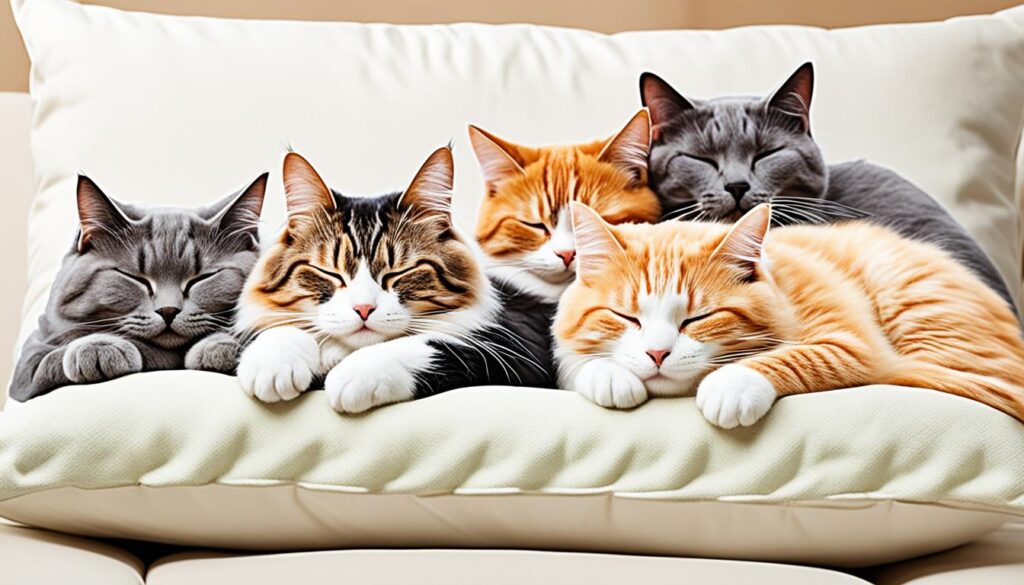
Understanding your pet’s sleeping preferences can provide valuable insights into their comfort and sense of security. Whether you have a cat or a dog, their sleeping positions and habitat choices can reveal a lot about their individual needs and preferences.
1. Cat Sleeping Positions
Cats are known for their unique and sometimes quirky sleeping positions. Here are some common sleeping positions and what they might indicate:
| Sleeping Position | Meaning |
|---|---|
| Cat sleeping at your feet or snuggling up to you | |
| Cat curling up in a tight ball | |
| Cat stretched out on its back | |
| Cat sleeping in a cat bed or cozy hiding spot |
These positions can indicate your cat’s desire to be close to you for comfort and security or their need for a relaxing and safe sleeping environment.
2. Dog Sleeping Preferences
Just like cats, dogs have their own sleeping preferences. Here are some common sleeping behaviors observed in dogs:
- Dogs sleeping in their kennels or crates
- Dogs curling up in a tight space
- Dogs sleeping on their backs with their paws up
- Dogs burrowing under blankets or pillows
These behaviors often indicate a dog’s need for a den-like sleeping area that provides them with a sense of safety and security.
It’s important to note that unusual sleeping positions or changes in your pet’s sleeping behavior can sometimes be a sign of discomfort or stress. For example, if your cat starts sleeping in their litterbox or your dog avoids their usual sleeping spots, it may be worth consulting with a veterinarian to address any underlying issues.
3. Creating an Ideal Sleeping Environment
Regardless of your pet’s sleeping preferences, creating a comfortable and soothing sleep environment is essential. Consider the following tips:
- Provide a cozy bed or spot specifically for your pet
- Ensure the sleeping area is quiet and free from disruptions
- Provide soft bedding and blankets for added comfort
- Keep the sleeping area at a comfortable temperature
- Offer toys or items with familiar scents for added reassurance
By understanding and accommodating your pet’s sleeping preferences, you can help them feel safe, secure, and well-rested.
Amount of Sleep Cats and Dogs Need
Cats and dogs have different sleep requirements based on their age, size, and lifestyle. Understanding and meeting their individual needs is essential for their overall health and well-being.
Cat Sleep Duration
Cats are known for their love of sleep, and they spend a significant portion of their day snoozing. On average, cats sleep for 12-16 hours a day. However, some cats, especially kittens and older cats, may need even more sleep, ranging from 18-20 hours a day.
Dog Sleep Duration
Dogs also require ample sleep to stay healthy and active. On average, dogs sleep for about 12-14 hours a day. However, puppies and larger breeds may need more sleep to support their growth and energy levels.
Pet Sleep Needs and Requirements
The sleep needs of cats and dogs can vary based on several factors, including breed, age, and activity level. For example, certain breeds may have specific sleep requirements due to their size or genetic predisposition. Additionally, young and active pets may need more sleep to recharge their batteries. It’s essential to pay attention to your pet’s individual needs and monitor their sleep habits to ensure they are getting enough rest.
Creating a comfortable sleep environment, providing regular exercise, and sticking to a consistent routine can help promote healthy sleep patterns for your pets. Consider their unique needs and consult with a veterinarian if you have any concerns about their sleep duration or quality.
Having a good understanding of your cat or dog’s sleep needs will help you provide them with the care they require for optimal health and happiness. Whether it’s ensuring they have a cozy spot to snooze or adjusting their sleep routine, meeting their sleep requirements is vital for their overall well-being.
Conclusion
Cats are fascinating creatures with unique sleep habits. Although they are not nocturnal, cats are crepuscular animals, meaning they are most active at dawn and dusk. These sleep patterns are deeply rooted in their natural hunting instincts and genetic makeup. As a pet owner, understanding and managing your cat’s sleep habits is crucial to ensuring their well-being and promoting better sleep for both of you.
Establishing a consistent sleep schedule is key to managing your cat’s sleep. Cats thrive on routine, so try to maintain a regular bedtime and waking time. Providing regular exercise and play sessions during the day can help burn off excess energy and contribute to a more restful sleep at night.
Creating a comfortable sleep environment for your feline friend is also important. Ensure that your cat has a cozy and designated sleeping area that is free from distractions and noise. Offering a soft bed or blanket can provide them with a sense of security and comfort.
If you have any concerns about your cat’s sleep habits or if they are experiencing sleep disturbances, it is essential to consult with a veterinarian. They can provide personalized advice and guidance based on your cat’s individual needs and health conditions.
Incorporating these tips into your cat’s daily routine can help manage their sleep patterns and promote better sleep. Ultimately, by understanding and meeting your cat’s sleep needs, you can foster a happier and healthier life for your beloved pet.
FAQ
Are cats nocturnal?
What are feline sleep habits?
Do cats have unique sleeping patterns?
What is the difference between nocturnal and crepuscular animals?
Why are cats active at night?
How do cats compare to big cats in terms of sleep patterns?
What are cat naps?
How can I manage my cat’s nighttime activity?
Should I consult a veterinarian about my cat’s sleep issues?
Do cats dream?
What do my pet’s sleeping preferences indicate?
How much sleep do cats and dogs need?
Can I manage my cat’s sleep habits?
References
|
International Cat Association (TICA) |
|
|
The Cat Fanciers’ Association (CFA) |
|
|
World Cat Federation (WCF) |
|
|
Fédération Internationale Féline (FIFe) |

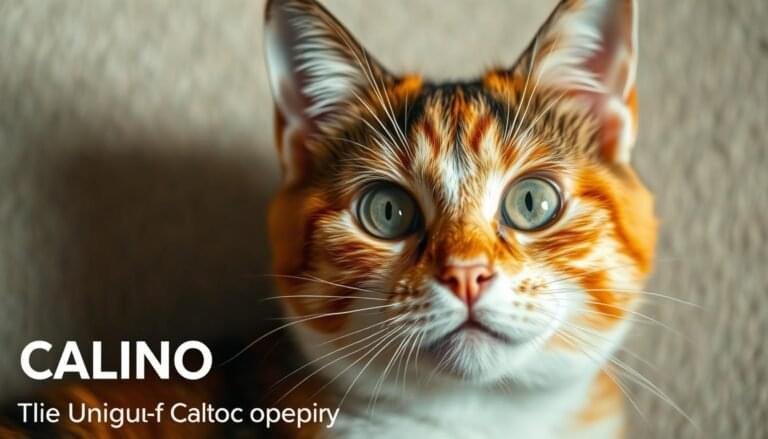
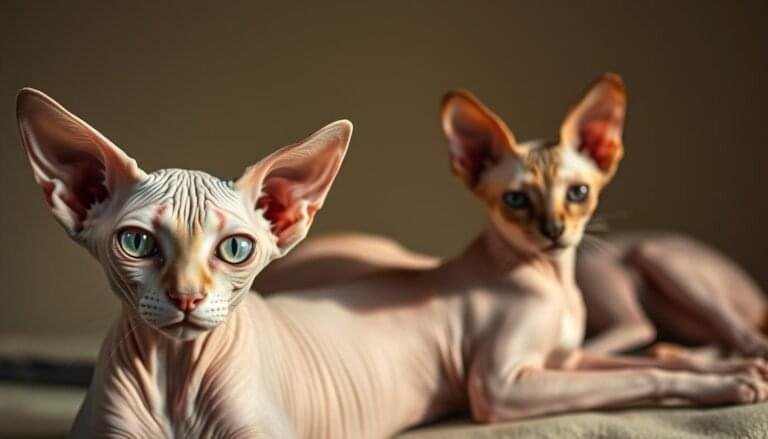
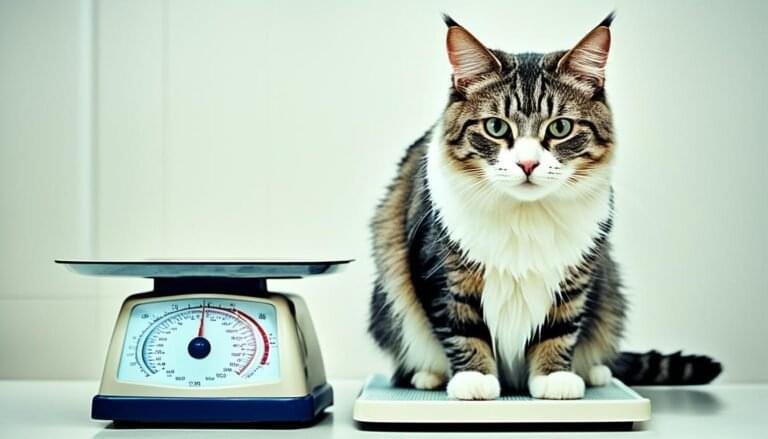




[…] coat, promoting their overall well-being. Let’s explore some of the physical benefits of feline grooming habits and the reasons behind cat […]
[…] you suspect that your cat is suffering from feline asthma, it’s essential to seek veterinary care. A thorough examination and diagnostic tests […]
[…] Improved litter box habits are observed in neutered male cats. […]
[…] their ancestors’ need to create a comfortable sleeping spot in the wild. It is believed that cats engage in kneading before settling down to sleep as a way to make the surface softer and more […]